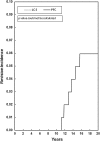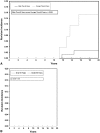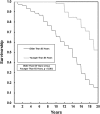What can be learned from minimum 20-year followup studies of knee arthroplasty?
- PMID: 25002210
- PMCID: PMC4390924
- DOI: 10.1007/s11999-014-3744-1
What can be learned from minimum 20-year followup studies of knee arthroplasty?
Abstract
Background: Long-term evaluation of knee arthroplasty should provide relevant information concerning the durability and performance of the implant and the procedure. Because most arthroplasties are performed in older patients, most long-term followup studies have been performed in elderly cohorts and have had low patient survivorship to final followup; the degree to which attrition from patient deaths over time in these studies might influence their results has been poorly characterized.
Questions/purposes: The purpose of this study was to examine the results at 20-year followup of two prospectively followed knee arthroplasty cohorts to determine the following: (1) Are there relevant differences among the two implant cohorts in terms of revision for aseptic causes (osteolysis, or loosening)? (2) How does patient death over the long followup interval influence the comparison, and do the comparisons remain valid despite the high attrition rates?
Methods: Two knee arthroplasty cohorts from a single orthopaedic practice were evaluated: a modular tibial tray (101 knees) and a rotating platform (119 knees) design. All patients were followed for a minimum of 20 years or until death (mean, 14.1 years; SD 5.0 years). Average age at surgery for both cohorts was >70 years. The indications for the two cohorts were identical (functionally limiting knee pain) and was surgeon-specific (each surgeon performed all surgeries in that cohort). Revision rates through a competing risks analysis for implants and survivorship curves for patients were evaluated.
Results: Both of these elderly cohorts showed excellent implant survivorship at 20 years followup with only small differences in revision rates (6% revision versus 0% revision for the modular tibial tray and rotating platform, respectively). However, attrition from patient deaths was substantial and overall patient survivorship to 20-year followup was only 26%. Patient survivorship was significantly higher in patients<65 years of age in both cohorts (54% versus 15%, p<0.001 modular tray cohort, and 52% versus 26%, p=0.002 rotating platform cohort). Furthermore, in the modular tray cohort, patients<65 years had significantly higher revision rates (15% versus 3%, p=0.0019).
Conclusions: These two cohorts demonstrate the durability of knee arthroplasty in older patients (the vast majority older than 65 years). Unfortunately, few patients lived to 20-year followup, thus introducing bias into the analysis. These data may be useful as a reference for the design of future prospective studies, and consideration should be given to enrolling younger patients to have robust numbers of living patients at long-term followup.
Level of evidence: Level III, therapeutic study. See Guidelines for Authors for a complete description of levels of evidence.
Figures




Similar articles
-
What Can We Learn From 20-year Followup Studies of Hip Replacement?Clin Orthop Relat Res. 2016 Feb;474(2):402-7. doi: 10.1007/s11999-015-4260-7. Clin Orthop Relat Res. 2016. PMID: 25800375 Free PMC article.
-
Wear and lysis is the problem in modular TKA in the young OA patient at 10 years.Clin Orthop Relat Res. 2011 Jan;469(1):41-7. doi: 10.1007/s11999-010-1429-y. Clin Orthop Relat Res. 2011. PMID: 20568028 Free PMC article.
-
How do knee implants perform past the second decade? Nineteen- to 25-year followup of the Press-fit Condylar design TKA.Clin Orthop Relat Res. 2015 Jan;473(1):135-40. doi: 10.1007/s11999-014-3792-6. Clin Orthop Relat Res. 2015. PMID: 25082622 Free PMC article.
-
Rotating-platform TKA no different from fixed-bearing TKA regarding survivorship or performance: a meta-analysis.Clin Orthop Relat Res. 2014 Jul;472(7):2185-93. doi: 10.1007/s11999-014-3539-4. Epub 2014 Mar 4. Clin Orthop Relat Res. 2014. PMID: 24590838 Free PMC article. Review.
-
Patient-relevant outcomes following elective, aseptic revision knee arthroplasty: a systematic review.Syst Rev. 2023 Aug 1;12(1):133. doi: 10.1186/s13643-023-02290-6. Syst Rev. 2023. PMID: 37528486 Free PMC article.
Cited by
-
Revision Surgery in Total Joint Replacement Is Cost-Intensive.Biomed Res Int. 2018 Sep 25;2018:8987104. doi: 10.1155/2018/8987104. eCollection 2018. Biomed Res Int. 2018. PMID: 30356391 Free PMC article.
-
What Can We Learn From 20-year Followup Studies of Hip Replacement?Clin Orthop Relat Res. 2016 Feb;474(2):402-7. doi: 10.1007/s11999-015-4260-7. Clin Orthop Relat Res. 2016. PMID: 25800375 Free PMC article.
-
Clinical outcomes of ceramic femoral prosthesis in total knee arthroplasty: a systematic review.J Orthop Surg Res. 2019 Feb 19;14(1):57. doi: 10.1186/s13018-019-1090-4. J Orthop Surg Res. 2019. PMID: 30782186 Free PMC article.
-
Larger range of motion and increased return to activity, but higher revision rates following unicompartmental versus total knee arthroplasty in patients under 65: a systematic review.Knee Surg Sports Traumatol Arthrosc. 2018 Jun;26(6):1811-1822. doi: 10.1007/s00167-017-4817-y. Epub 2017 Nov 28. Knee Surg Sports Traumatol Arthrosc. 2018. PMID: 29185005
-
Effect of severity and cause of preoperative anemia on the transfusion rate after total knee arthroplasty.Sci Rep. 2022 Mar 8;12(1):4083. doi: 10.1038/s41598-022-08137-9. Sci Rep. 2022. PMID: 35260783 Free PMC article.
References
-
- Callaghan JJ, O’Rourke MR, Iossi MF, Liu SS, Goetz DD, Vittetoe DA, Sullivan PM, Jonston RC. Cemented rotating-platform total knee replacement. a concise follow-up, at a minimum of fifteen years, of a previous report. J Bone Joint Surg Am. 2005;87:1995–1998. doi: 10.2106/JBJS.D.03039. - DOI - PubMed
Publication types
MeSH terms
LinkOut - more resources
Full Text Sources
Medical
Research Materials

